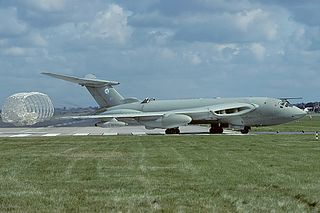Related Research Articles

The "V bombers" were the Royal Air Force (RAF) aircraft during the 1950s and 1960s that comprised the United Kingdom's strategic nuclear strike force known officially as the V force or Bomber Command Main Force. The three models of strategic bomber, known collectively as the V class, were the Vickers Valiant, which first flew in 1951 and entered service in 1955; the Avro Vulcan, which first flew in 1952 and entered service in 1956; and the Handley Page Victor, which first flew in 1952 and entered service in 1957. The V Bomber force reached its peak in June 1964 with 50 Valiants, 70 Vulcans and 39 Victors in service.

The Avro Vulcan is a jet-powered, tailless, delta-wing, high-altitude, strategic bomber, which was operated by the Royal Air Force (RAF) from 1956 until 1984. Aircraft manufacturer A.V. Roe and Company (Avro) designed the Vulcan in response to Specification B.35/46. Of the three V bombers produced, the Vulcan was considered the most technically advanced, hence the riskiest option. Several reduced-scale aircraft, designated Avro 707s, were produced to test and refine the delta-wing design principles.

The Vickers Valiant was a British high-altitude jet bomber designed to carry nuclear weapons, and in the 1950s and 1960s was part of the Royal Air Force's "V bomber" strategic deterrent force. It was developed by Vickers-Armstrongs in response to Specification B.35/46 issued by the Air Ministry for a nuclear-armed jet-powered bomber. The Valiant was the first of the V bombers to become operational, and was followed by the Handley Page Victor and the Avro Vulcan. The Valiant is the only V bomber to have dropped live nuclear weapons.

The Handley Page Victor is a British jet-powered strategic bomber developed and produced by Handley Page during the Cold War. It was the third and final V bomber to be operated by the Royal Air Force (RAF), the other two being the Vickers Valiant and the Avro Vulcan. Entering service in 1958, the Victor was initially developed as part of the United Kingdom's airborne nuclear deterrent, but it was retired from the nuclear mission in 1968, following the discovery of fatigue cracks which had been exacerbated by the RAF's adoption of a low-altitude flight profile to avoid interception, and due to the pending introduction of the Royal Navy's submarine-launched Polaris missiles in 1969.

Royal Air Force Waddington otherwise known as RAF Waddington is a Royal Air Force (RAF) station located beside the village of Waddington, 4.2 miles (6.8 km) south of Lincoln, Lincolnshire, in England.

Royal Air Force Finningley or RAF Finningley was a Royal Flying Corps and Royal Air Force station at Finningley, in the Metropolitan Borough of Doncaster, South Yorkshire, England. The station straddled the historic county boundaries of both Nottinghamshire and the West Riding of Yorkshire.
No. 635 Squadron RAF was a heavy bomber squadron of the Royal Air Force during the Second World War.

No. 543 Squadron RAF was a photographic reconnaissance squadron of the Royal Air Force, active in two periods between 1942 and 1974.

Royal Air Force Station Stornoway or more simply RAF Stornoway is a former Royal Air Force station near the burgh of Stornoway, on the Isle of Lewis, in the Western Isles of Scotland. No. 112 Signals Unit Stornoway was also part of the RAF's activity on the airfield.

No. 35 Squadron was a squadron of the Royal Air Force.
No. 684 Squadron RAF was a photo-reconnaissance squadron of the Royal Air Force from 1943 to 1946.
No. 682 Squadron RAF was a photo reconnaissance squadron of the Royal Air Force during the Second World War.
No. 681 Squadron RAF was a photo-reconnaissance squadron of the Royal Air Force during the Second World War.

Number 57 Squadron, also known as No. LVII Squadron, is a Royal Air Force flying training squadron, operating the Grob Prefect T1 from RAF Cranwell, Lincolnshire.
No. 680 Squadron RAF was a photo-reconnaissance squadron of the Royal Air Force, active during the Second World War.
No. 608 Squadron was an Auxiliary Air Force squadron of the Royal Air Force during the Second World War. It flew during its existence as a bomber, fighter and reconnaissance unit and was the only RAF squadron to be equipped with the unsuccessful Blackburn Botha torpedo bomber.

No. 627 Squadron was a Royal Air Force Mosquito aircraft pathfinder bomber squadron that operated during the Second World War.
112 Signals Unit, RAF Stornoway was a classified Royal Air Force (RAF) Electronic countermeasures (ECM) measurement and evaluation unit based at Stornoway Airport on the Isle of Lewis in the Outer Hebrides. It was an RAF Bomber Command Headquarters (HQBC) directly administered unit established during the height of the Cold War.

No. 7 Wing (SAAF) was a South African Airforce fighter-bomber air wing during World War II. The Wing served in the Western Desert and Italian campaigns. By the end of the North African campaign in May 1943, SAAF No 7 Wing, comprising 2, 4 & 5 Squadrons, was considered the best dive bomber formation in the world.
References
- ↑ "THE CEO IS MOVING ON, Andrew Brookes bids farewell" (PDF). Air League. Archived (PDF) from the original on 21 June 2020.
- ↑ Thisdell, Dan (14 June 2010). "Flightglobal interview". Flightglobal.com. Flight Global. Retrieved 9 September 2011.
{{cite web}}: CS1 maint: url-status (link) - ↑ "Aerospace Journalist of the Year Award - Winners". Ajoya.com. Archived from the original on 3 September 2011. Retrieved 9 September 2011.
- ↑ "Aerospace Journalist of the Year Award - Winners". Ajoya.com. Archived from the original on 3 September 2011. Retrieved 9 September 2011.